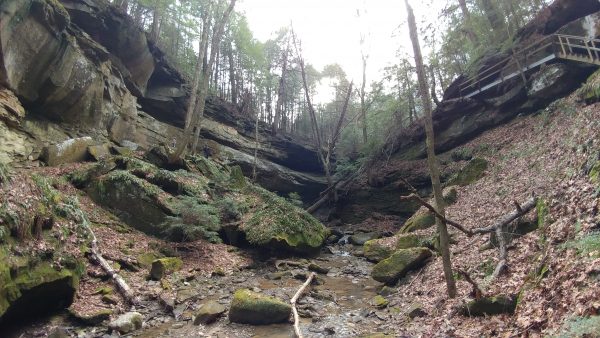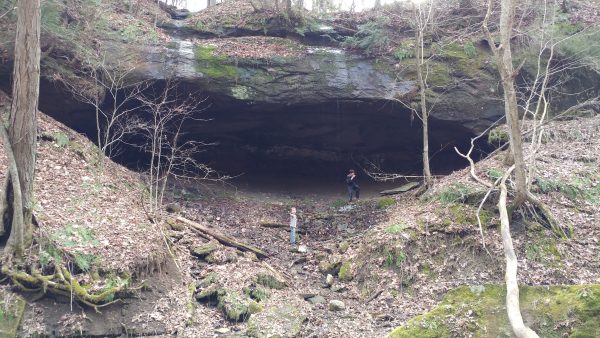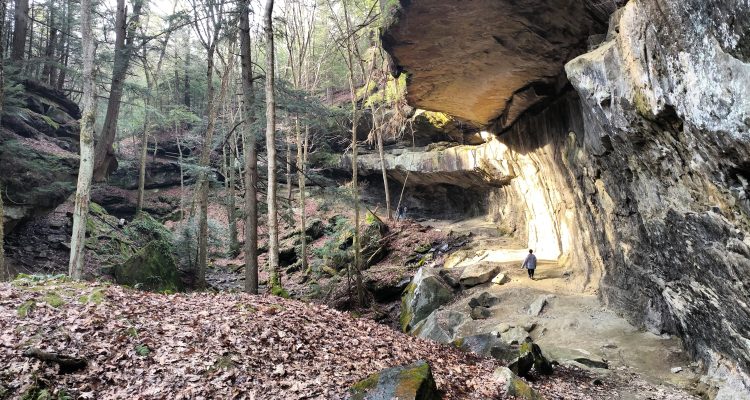When I was a child, my father took me to a wild and rocky place far from home. I don’t have any concrete memories of the experience; it’s one of those recollections I formed from the stories he’s told over the years. In my mind’s memory, I see giant boulders and deep shade, and I see myself climbing up and over, down and through these rocks. It felt like a foreign land.
In reality, I was only across the river in Beallsville, Ohio, at Raven Rocks. Belmont is a big county, to be sure, but it wasn’t actually a land far from home—just a 50-minute drive. True, to a 10-year-old, that feels like a lifetime, especially when you’re sitting in the rear of a station wagon with a barf bucket in your lap and hot Irish Setter breath on the back of your neck. Thankfully, now, I’m the adult, and when I took my own kids to Raven Rocks on a warm February day, I was smart enough to give them Dramamine for the drive over hill and dale.
You know the really great thing about Dramamine? Not only does it keep the yak off your seats, but it also sedates them faster than you can bark, “I will turn this car around!” And I don’t know about you, but I find that quality family time is always more enjoyable when the children are unconscious. (Don’t worry: they woke when we arrived and picked up right where they’d left off, with Ben’s boot in Andy’s left eye socket and Andy’s suggestion that the tooth fairy might bludgeon Ben to death in his sleep working its terrible magic on Ben’s brain. All good.)
Raven Rocks, in southern Belmont County, was a ceremonial site for Native Americans around 760 A.D. It’s a hidden ravine, tucked into a valley that looks like all the others around here, tight and narrow and crowded with eastern hardwoods. I’ve yet to uncover the specific geologic history of the 1,255 acres in the private park, but it’s an unusual formation for our neck of the woods. The stream flows over a waterfall and has carved out a gorge where cliffs overhang and Eastern Hemlock grow in the cool air.

Though the boys griped and complained about being dragged from the hypnotic monotony of their video games, we went to Raven Rocks one Saturday in late winter. And they were so glad their mother talked them into it. It’s a kid’s paradise. They found puddles to jump into, crawdad to hunt, and caves to explore. The geology is the star, here, because if there’s one thing kids absolutely love, it’s rocks. Boulders. Things to climb and toss and chuck and roll and fall off. We clambered down to the base of the waterfall and felt its spray. We scrambled over huge rockfalls and ducked into secret places where old carvings recalled lives long ended. I sat in the mouth of an overhang and smelled the deep green moss while my kids slid down the hill.
Raven Rocks is more than just an afternoon hike through a ravine, though. Purchased in 1970 by a group of 19 individuals, all of whom were teachers or students at Barnesville’s Olney Friends School, the goal was not only to preserve the unique natural area, but also to form a sustainable community. While the word sustainable feels like it belongs to our present decade, a 1999 Times Leader article reveals that the Raven Rocks group had begun sustainable practices like installing energy-efficient appliances, composting toilets, and an electricity-generating windmill years before. They eschewed pest control and fertilizer, and practiced organic farming. The money to fund the project came from a Christmas tree farm on the property.
Several buildings sit on the Raven Rocks site, including the earth-sheltered, solar-powered home of Mary and Richard Sidwell, retired Olney faculty and part of the founding members of the community. In addition, a larger structure known as Locust Hill has been under construction since the 1970’s. When complete, the building will serve as a sustainable environmental living space. Huge, southern-facing windows allow sunlight to heat both structures, and large greenhouses facilitate the production of food. Out in the fields, Raven Rocks practices organic farming. A mobile chicken coop allows the birds to follow the cattle and obtain most of their protein from insect larvae in the cow chips. It’s weird, but it’s efficient.
You can plan to visit Raven Rocks for a few hours. It takes 50 minutes to get there from Wheeling, and less than that from St. Clairsville, Powhattan, or Belmont. We spent an hour hiking around the gorge, exploring the waterfall and the caves. If your kids are like mine, you might allow an extra 20 minutes to fish them out of the stream, strip them of their wet clothing, apply surgical glue to gashes, and Heimlich the pine cones out of their throats. They’ll be filthy and exhausted and will have forgotten all about video games. It’ll be great.

It’s funny how life moves in circles. When my dad was about 10, he and my grandfather took a spur-of-the-moment drive to Raven Rocks one afternoon in the 1950’s. Thirty years later, on a whim, my dad found himself at the same location with 10-year-old me. And 30 years later still, I brought 10-year-old Andy (and Ben, too) to Raven Rocks. It’s not a place I need to visit every month, but now that I’ve reacquainted myself with it, I think it needs to be on my Saturday hiking agenda once in a while.
Remember the health benefits of time spent in nature. It’s proven to reduce stress, lower blood pressure, and boost positivity. And while most of us don’t have the time to escape into the mountains every weekend, there are places nearby that feel wild. Raven Rocks hides in the quiet edges of Belmont County. Go check it out.




